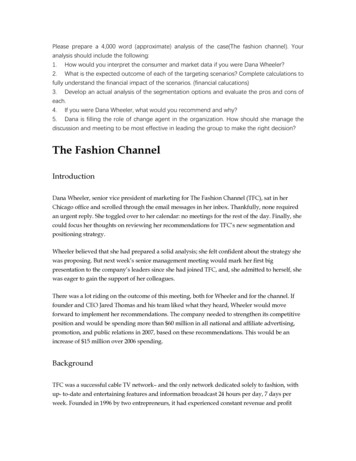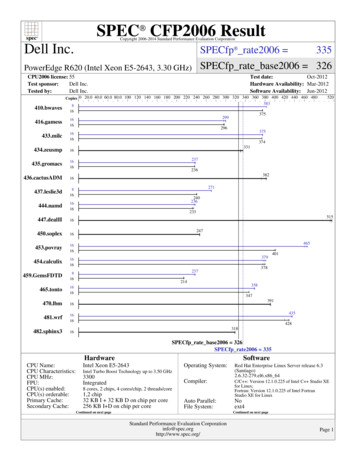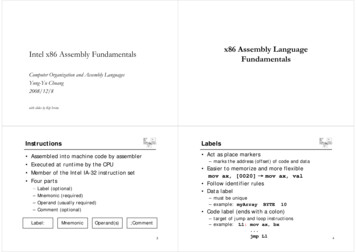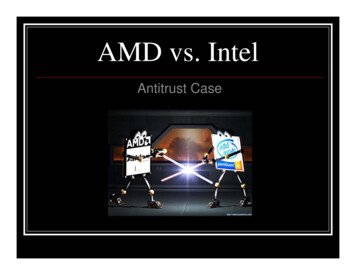
Transcription
Please prepare a 4,000 word (approximate) analysis of the case(The fashion channel). Youranalysis should include the following:1. How would you interpret the consumer and market data if you were Dana Wheeler?2. What is the expected outcome of each of the targeting scenarios? Complete calculations tofully understand the financial impact of the scenarios. (financial calucations)3. Develop an actual analysis of the segmentation options and evaluate the pros and cons ofeach.4. If you were Dana Wheeler, what would you recommend and why?5. Dana is filling the role of change agent in the organization. How should she manage thediscussion and meeting to be most effective in leading the group to make the right decision?The Fashion ChannelIntroductionDana Wheeler, senior vice president of marketing for The Fashion Channel (TFC), sat in herChicago office and scrolled through the email messages in her inbox. Thankfully, none requiredan urgent reply. She toggled over to her calendar: no meetings for the rest of the day. Finally, shecould focus her thoughts on reviewing her recommendations for TFC’s new segmentation andpositioning strategy.Wheeler believed that she had prepared a solid analysis; she felt confident about the strategy shewas proposing. But next week’s senior management meeting would mark her first bigpresentation to the company’s leaders since she had joined TFC, and, she admitted to herself, shewas eager to gain the support of her colleagues.There was a lot riding on the outcome of this meeting, both for Wheeler and for the channel. Iffounder and CEO Jared Thomas and his team liked what they heard, Wheeler would moveforward to implement her recommendations. The company needed to strengthen its competitiveposition and would be spending more than 60 million in all national and affiliate advertising,promotion, and public relations in 2007, based on these recommendations. This would be anincrease of 15 million over 2006 spending.BackgroundTFC was a successful cable TV network– and the only network dedicated solely to fashion, withup- to-date and entertaining features and information broadcast 24 hours per day, 7 days perweek. Founded in 1996 by two entrepreneurs, it had experienced constant revenue and profit
growth above the industry average almost since the beginning. Revenues for 2006 were forecastat 310.6 million, marking another steady upswing.The channel was also one of the most widely available niche networks, reaching almost 80million U.S. households that subscribed to cable and satellite television.1 Women between 35 and54 years were its most avid viewers, according to its annual demographic survey. But beyondbasic demographics, the channel didn’t have much in the way of detailed information about itsviewers. Nor did it attempt to market to any viewer segments in particular. From the beginning,in fact, Jared Thomas had believed that TFC’s marketing messages should appeal to as broad agroup as possible in order to achieve the highest possible viewership numbers. Early on, thenetwork had chosen “Fashion for Everyone” as the theme for its marketing programs; one of itsmore popular series in 2005 had been “Look Great on Saturday Night for Under 100.”TFC had clearly grown quickly without articulating any detailed segmentation, branding, orpositioning strategy. However, at the beginning of 2006, the network realized that other networkswere taking note of its success and beginning to add fashion-related programming to their lineups. TFC was facing competition that could provide meaningful choices to both viewers andadvertisers. By June 2006, these new competitive dynamics had prompted Thomas to rethink hisapproach to marketing. At the quarterly executive meeting that month, he told his senior team:“It’s time for us to build a modern brand strategy and secure The Fashion Channel’s position asthe market leader. I want to use marketing to lay a foundation for future growth.” At the samemeeting, Thomas had announced plans to sharply increase TFC’s investment in advertising andto hire an experienced marketer to develop marketing and brand-building programs to supportTFC’s continued growth.Enter Dana Wheeler, in July 2006. Wheeler had a strong background in marketing for packagedconsumer products as well as broad experience in the advertising industry. Thomas expected thatWheeler would draw on these strengths to help TFC build on the momentum it had created todate and stave off any competitors trying to make inroads. Still, he and some of the othermembers of the leadership team felt an urge to resist change. The network had been highlysuccessful to date and no one wanted to “break something that isn’t broken.”Wheeler’s PlansWheeler turned back to her computer, opened up the slide-deck presentation she had created,and started reviewing it. As she began to page through the materials, she was thinking about thetrends in the advertising marketplace that Norm Frazier had been talking about in the salesforecasting meeting this morning.Frazier, senior vice president of Advertising Sales, had warned that TFC might need to drop theprice for a unit of advertising next year by 10% or more if the network did not make somechanges in its performance. He mentioned that both Lifetime and CNN had launched fashion-
specific programming blocks that were achieving notable ratings (Exhibit 1). Frazier was a highenergy salesman who had personally built the strong ad sales performance of the channel. Hewas justifiably worried. Wheeler had left that meeting acutely aware that next week’s executivesession wasn’t coming a moment too soon.Wheeler knew that in order to hold or increase price it would be crucial to attract a critical massof viewers who were interested in the network’s content and were also attractive to advertisers.The key would be targeting the right viewers and offering advertisers an attractive mix ofviewers when compared with what competitors were offering. Wheeler believed she had goodmarket data that would give her insights into the options for identifying the right segments forTFC. At the same time, she knew that the network needed to maintain its overall audience ratingswith the cable consumers and the cable affiliate distribution network. If the network changed itsofferings in a way that disappointed too many cable subscribers, it could risk losing itsdistribution support.Wheeler clicked to the slide that outlined the marketing tools in her arsenal, and then clicked to aslide near the end of the presentation that revealed an aggressive implementation schedule. Herplan was to build a strategy for segmentation, and use it as a base to employ all of the marketingtools— traditional and internet advertising, public relations and promotions—to reach the targetconsumers with integrated positioning messages. She also knew that it would take time to createand launch all the elements of a well-integrated marketing program and that there was no time towaste.She moved back a dozen slides or so, opening the ones that summarized TFC’s revenue streamfrom advertising sales and the slides that considered its revenue stream from cable-affiliate fees.Thomas and the rest of the senior management team knew this data as well as she did, sheassumed. Everyone felt that advertising was TFC’s primary growth opportunity. She wanted tothink about her key messages one more time to ensure her recommendations would supportbuilding revenues as aggressively as possible.TFC’s Advertising Revenue ModelFirst, she reviewed TFC’s advertising revenue model. TFC was on target to generate 230.6million in 2006 from advertising. The advertising business model was built on attracting a mix ofmale and female viewers on a regular basis as measured by “ratings” (the percentage oftelevision households watching on average during a measured viewing period.) Across the entireschedule, TFC’s average rating was 1.0. With 110 million television households in the UnitedStates, this meant that on average 1,100,000 people were watching at any point in time.2TFC’s Ad Sales team sold access to these viewers via advertising spots (30 or 60 seconds inlength) to a variety of well-known consumer marketers ranging from cosmetics companies tobrand name clothing designers and automobile manufacturers. There were usually six minutes of
national ad time in each half hour of programming, 24 hours per day for a total of 2,016 minutesper week. Wheeler knew from industry studies that, in 2006, U.S. consumer advertisers spentalmost 20 billion buying spots on cable networks such as TFC. Because there were severalhundred cable networks competing for viewers and the related ad dollars, competition for adrevenue was always fierce across all the networks.While competition was intense for advertising overall, TFC remained the only network dedicatedto fashion programming 24 hours per day, 7 days per week. This set up an interestingcompetitive dynamic. TFC needed to compete against a broad range of networks for advertisingrevenues. For these networks the ad buyers would be most interested in buying ratings anddemographics, and less interested in specific programming subjects. At the same time TFCcompeted against other fashion- oriented programming that would appeal to advertisers whospecifically wanted to participate in that programming context. The strong fashion programmingblocks on Lifetime and CNN represented a double-edged competitive challenge. And ifsuccessful, more networks would likely copy the concept, skimming more viewers and ad dollarsfrom TFC.Dana reminded herself about the conversation she’d had with Norm Frazier about advertisingpricing. The network based ad unit prices on several factors, which advertisers also monitored,including the number of viewers (ratings), the audience’s characteristics (age, demographics, andlifestyle), and general competitive trends. Prices were expressed as CPM (cost per thousand),which represented the price that an advertiser would pay for an “impression,” or moment ofviewing.3 The ad market was dynamic because of the relatively fixed supply of advertising ontraditional television networks. Market pricing moved up and down frequently, as advertisersdeveloped new campaigns that required television support. And, in recent years, the advertisingbuying process had become very sophisticated, with many buying agencies and clients usingcombinations of surveys and “optimizer” programs to analyze the demographic andpsychographic characteristics of audience groups and then establish pricing parameters that fitthe audiences various networks delivered. The output of these programs would be arecommended advertising placement portfolio for a specific product campaign.Networks were increasingly evaluated on their ability to deliver specific target groups. Generally,networks whose audiences were older or had low family incomes commanded lower rates foradvertising. Advertisers would pay a premium CPM to reach certain other groups; in 2006, thesewere men of all ages and women aged 18-34. By increasing the ratings in highly valueddemographic groups, the TFC Ad Sales team could achieve CPM pricing increases from 25% to75%. By attracting a large number of highly valued viewers, the network had the opportunity tosubstantially grow its advertising revenues.Cable Affiliate Fees
Wheeler next turned to the slides that dealt with the cable affiliate fee revenue stream. Cableaffiliate fees, which were on track to bring in 80 million in 2006, were the second source of TFCrevenue. Most U.S. households subscribed to cable television through local affiliates of a largecable multi-system operator (nationally, Comcast, Time Warner, Cablevision, and Cox were thelargest). Consumers paid a monthly fee for a basic lineup of channels and incremental fees forpremium channels and on-demand programming. TFC was positioned as a basic channel, somost consumers received it automatically when they signed up for basic cable service.Large multi-system operators (MSO) would sign multi-year contracts with networks thatspecified the fee the network would receive for each household that received the channel. Thelocal affiliates of that MSO marketed and distributed the service to consumers in all the localmarkets for which they held a franchise. For TFC, this negotiated subscriber fee averaged 1.00per subscriber per year. The fee was paid entirely on the basis of carriage and did not go up ordown as viewership changed. The TFC fee was at the low end of the industry range, reflectingthe specialty niche content of the network. ESPN, and other networks that appealed to largenumbers of households, charged the highest fees. Wheeler knew that the cable operators andaffiliates carefully monitored customer satisfaction with network offerings and would threaten todrop unpopular channels. There were case studies of networks causing viewer outcry fromunpopular changes. Consequently, it was important for TFC to maintain its general satisfactionlevel and keep the affiliates happy. Because TFC was widely distributed there was not muchupside in affiliate revenue, though, and the general goal for both parties was to maintain a goodequilibrium.Wheeler closed the slide deck entirely. As far as cable affiliate revenue went, there wasn’t muchto be done, she thought. The network had already achieved virtually full penetration of availablecable households and there was limited opportunity to raise fees. Wheeler knew that the two keylevers to drive revenue growth would be (1) increased viewership (ratings), and (2) increasedadvertising pricing.She pulled out a legal pad and wrote: “Deliver quality audiences, as demanded by advertisers”across the top in large print.Competitive ThreatsThe phone rang, breaking her concentration. “Dana,” boomed Norm Frazier. “I’m running to aclient meeting but just wanted to connect with you. I wanted to say, in the meeting next week, Ihope we’ll be able to talk about how to pitch TFC against
TFC. At the same time, she knew that the network needed to maintain its overall audience ratings with the cable consumers and the cable affiliate distribution network. If the network changed its offerings in a way that disappointed too many cable subscribers, it could risk losing its distribution support. Wheeler clicked to the slide that outlined the marketing tools in her arsenal, and then .











